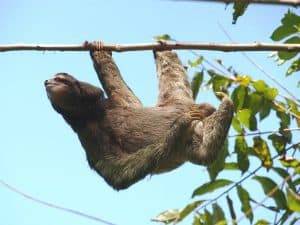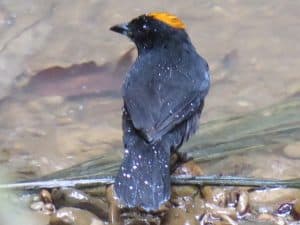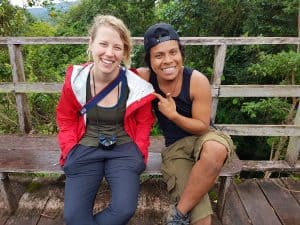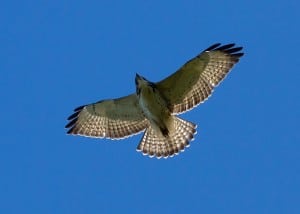If Costa Rica taught me one lesson, it was to never go anywhere without my binoculars and camera. Not to put clothes on the line, not to go for water and especially not to walk into town. I could be certain that some kind of exotic creature – be it a sloth, a toucan, a poison dart frog or a new bird species – would pop up right in front of me, almost begging to be identified or for its picture to be taken.
My wife Michelle and I, along with our friends Mike and Sonja Barker, had the pleasure this winter of spending four weeks in Puerto Viejo de Talamanca, Costa Rica. Our daughter Sophie, and Mike and Sonja’s daughter Karina, also joined us for part of the time. Puerto Viejo is located on the southern Caribbean coast near the border of Panama. We chose this area for two reasons. First, we had never been there before but knew that the temperature is more moderate than on the Pacific side. Equally important, there is still a large areas of primary rainforest, which has been relatively unaffected by human activities.
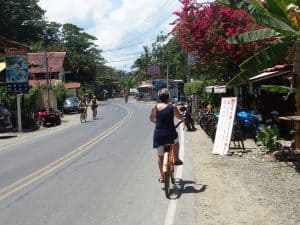
Bicycles are a common means of transportation in Puerto Viejo – for locals and tourists alike. (photo: Drew Monkman)
This region is the heart and soul of Costa Rica’s Afro-Caribbean community. Approximately one-third of the people living here are the descendents of immigrants who came here from countries such as Jamaica at the end of the 19th century. Their distinct culture is immediately recognizable in their clothes, food, music and, of course, language. Although they are all fluent in Spanish, many also speak an idiom known as ‘Limon Creole’, which is a mix of English, Spanish and other influences. This area is also home to the country’s most prominent and culturally intact indigenous groups who inhabit the Kekoldi, Cabecar and Bribri territories. Since the 1980s, the southern Caribbean has become a popular destination for large numbers of European and, increasingly, North American tourists, many of whom have chosen to stay and become business owners. Tourists are attracted by the rich cultural diversity as well as the beautiful beaches, great surfing, amazing biodiversity and spectacular land and seascapes. The area also has wonderful restaurants and cafés.
Loco Natural
We rented a three-bedroom house at Finca Loco Natural from a lovely Chilean and American couple, Pamela and Carter. It was only a 20-minute walk from town and just five minutes from the ocean. Nestled in seven acres of Heliconia gardens, flowering shrubs and towering trees – and backing onto rainforest – the ‘Bird House’ was everything a nature enthusiast could ask for. It was a treat for all of the senses. Every morning we awoke to the non-stop, frog-like clicking of Keel-billed Toucans, the wing-snapping of White-collared Manakins, the harsh squawking of Gray-cowled Wood-rails and the cacophonous cries of Howler Monkeys. The approach of nightfall was signaled by the loud, far-carrying “gwa-co” of the Laughing Falcon, followed shortly after by the throaty growl of the Great Potoo and eventually by the gentle hooting of the Spectacled Owl.
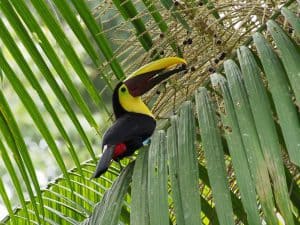
A Black-mandibled Toucan photographed from the kitchen table at Finca Loco Natural (photo: Drew Monkman)
In the middle of the day when bird activity slowed down, butterflies took centre stage. At times, it was like being in a butterfly conservatory as Julias, Banded Peacocks, Blue Morphos and various species of Heliconius and Caligos butterflies flitted about. Identifying them is no easy task, since the country has more than 1300 species. Compare this to only 300 in all of Canada!
Occasionally, a Blue Morpho would fly right through the kitchen or balcony, since they were both completely open on three sides with no windowpanes or screens. This meant that visitors of the non-human variety were common house guests. In addition to butterflies, these included giant six-inch walking sticks, geckos, leaf-like katydids, frogs, moths, hummingbirds and, on one occasion, even some fruit bats, which gobbled up most of a banana we had left on the counter. An added bonus was the rich, blossom-scented air, often courtesy of two Ylang-Ylang trees that grew behind the house.
A highlight of each day was simply sitting at the kitchen table – a cup of exquisite Costa Rican coffee in hand – and watching the parade of mammals, birds and butterflies attracted by the diverse flora. On numerous occasions, Howler Monkeys and Three-fingered Sloths provided spectacular entertainment and photo ops one can only dream of. Agoutis, a large, comical, guinea pig-like rodent, were regular visitors, too. For me, however, it was the birds that stole the show. These included outrageously coloured toucans like the Keel-billed, Black-mandibled and Collared Aracaris, boisterous Montezuma Oropendolas, exquisite Long-tailed Hermit hummingbirds and flashy Passerini’s and Tawny-crested Tanagers. Many of the birds fed in palm and Cecropia trees only metres from where we sat. As Sonja remarked, “The problem here is not Nature Deficit Disorder, it’s total Nature Overload Disorder!”
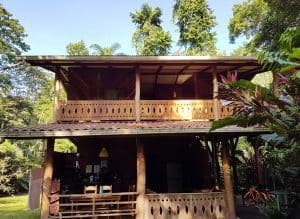
The kitchen and balcony of the ‘Bird House’ that we rented are open to the elements on three sides. (photo: Drew Monkman)
How right she was. I was hardly able to sleep, given all there was to discover. I headed out each morning at about 6 am to take advantage of peak bird activity. A favorite destination was a nearby Cecropia tree, where I snapped pictures of the parade of birds coming to feed on the seeds. These often included oropendolas, Gray-headed Chachalacas, Buff-throated Saltators, Social Flycatchers as well as Blue-gray, Palm and Passerini’s Tanagers.
Creek and pool
Pamela suggested we explore a nature trail on the property that leads to a creek and, a short distance upstream, to a lovely waterfall. As we walked through the ankle-deep water, we were thrilled to find both Strawberry and Green-Black Poison Frogs on the steep, shaded banks. I had no idea these frogs were still so common. Giant Helicopter Damselflies fluttered overhead – flying just like their namesake suggests – while insanely tame Tawny-crested Tanagers bathed along the stream edge. We stopped at one point to admire a giant fig tree with massive, four-foot-high buttress roots spreading out on all sides. This root design is an adaptation to the shallow, nutrient-poor rainforest soil and improves the tree’s ability to withstand strong winds. Finally arriving at the waterfall, the cool, clear water felt wonderful as it spilled over us. It was a scene right out of a Costa Rica tourist ad!
The small swimming pool at Finca Loco Natural was another favourite hangout – and not just because of the refreshing water. It also provided wonderful nature-viewing. Much of the time, it was nearly impossible to sit and read. There was almost always a sloth, a family of monkeys or a flock of toucans or oropendolas to grab our attention. A four-foot-long Green Iguana was also a source of constant entertainment, especially when it relieved itself on the vegetation below! With four pairs of eyes doing the watching, we continually spotted new and interesting birds. Two of the rarer species we observed from the pool area included a Bat Falcon – actually feasting on a bat – and a regal, adult King Vulture. Sonja spotted the huge black and white bird as it soared overhead among hundreds of migrating Turkey Vultures.
Guides
You can’t experience the full diversity of tropical bird life without hiring the services of a guide. Finding many species depends on recognizing their vocalizations – a major undertaking in a country of over 900 species – and having local knowledge of their whereabouts. I was lucky to go birding with three highly talented and passionate individuals, all of whom seemed to enjoy themselves as much as I did. They were Keysaur (Kesh) Hernandez, Alex Paez Balma and Abel Bustamante. Kesh and Alex are indigenous guides of the Kekoldi community.
The morning Sophie and I spent with Kesh was an amazing introduction to the rich biodiversity and indigenous culture of the area. Not only does Kesh speak five languages, but he is also one of the most enthusiastic and profoundly ethical guides I have ever met. He moved effortlessly along the steep and muddy rainforest trail, reminding us to talk in whispers. At regular intervals, he would stop to point out the songs of elusive species like antbirds, treecreepers and wrens – all of which he imitated in a near-perfect whistle. At one point, his whistling brought a Stripe-breasted Wren almost to our feet.
Thanks to Kesh, we saw hummingbird and manakin leks (an area where males display for females), bullet ants, huge orb spiders, glass-winged butterflies and even a family group of rare Spider Monkeys swinging through the treetops. He even invited us to suck out the nectar of Heliconia blossoms to show us why hummingbirds are so attracted to them. As we walked past a small farm, we sampled the delicious fruit of Cherimoya and Star Apple trees, while he spoke at length about the importance of cocoa beans to health and to indigenous culture.
The highlight of the morning, however, was spending several hours at the top of the Kekoldi Hawkwatch raptor-viewing tower. This area of Costa Rica is considered one of the four best locations in the world to see migrating hawks, kites, falcons and vultures during spring and fall migration. Two to three million raptors pass over the region each year. As we looked out over the forest canopy – the Caribbean Sea to the east and the mountains of Panama to the west – a river of Turkey Vultures, Broad-winged Hawks, Swainson’s Hawks, Ospreys, Peregrine Falcons and Plumbeous Kites streamed by, slowly making their way northward. Although the migration had only just begun, it was an experience I’ll never forget. We were also treated to an array of tropical songbird superstars like Golden-hooded Tanagers and Shiny Honeycreepers as they perched in the treetops, illuminated by the morning sun.
Next week, I’ll share more of my Costa Rica adventures and talk about threats such as climate change.
